2016 HONDA CIVIC COUPE child lock
[x] Cancel search: child lockPage 4 of 585

Contents
Child Safety P. 58 Exhaust Gas Hazard P. 70 Safety Labels P. 71
Opening and Closing the Trunk P. 133 Security System P. 136 Opening and Closing the Windows P. 139
Operating the Switches Around the Steering Wheel P. 143 Adjusting the Mirrors P. 157
Interior Lights/Interior Convenience Items P. 168 Climate Control System P. 179
Audio Error Messages P. 283 General Information on the Audio System P. 286
When Driving P. 386 Braking P. 445 Parking Your Vehicle P. 461
Fuel Economy P. 467 Accessorie s and Modifications P. 468
Maintenance Under the Hood P. 483 Replacing Light Bulbs P. 498
Checking and Maintaining Tires P. 510 Battery P. 519 Remote Transmitter Care P. 521
Cleaning P. 524
Engine Does Not Start P. 537 Jump Starti ng P. 540 Shift Lever Does Not Move P. 543
Fuses P. 552 Emergency Towing P. 556 When You Cannot Unlock the Fuel Fill Door P. 557
Devices that Emit Radio Waves P. 567 Reporting Safety Defects P. 568
Authorized Manuals P. 573 Customer Service Information P. 574
Quick Reference GuideP. 4
Safe DrivingP. 31
Instrument PanelP. 73
ControlsP. 113
FeaturesP. 187
DrivingP. 379
MaintenanceP. 469
Handling the UnexpectedP. 529
InformationP. 561
IndexP. 575
16 CIVIC 2D HC2 (0A 01 0C)-31TBG6000.book 3 ページ >0>.>/6年>0月>/>0日 金曜日 午後4時>/6分
Page 36 of 585
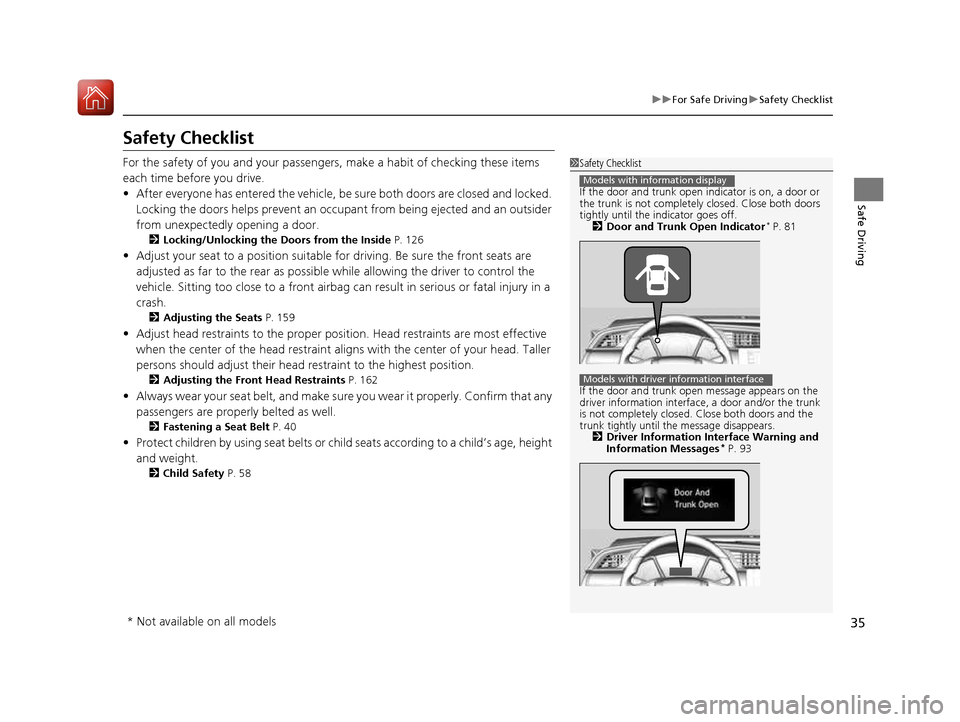
35
uuFor Safe DrivinguSafety Checklist
Safe Driving
Safety Checklist
For the safety of you and your passengers, make a habit of checking these items
each time before you drive. •After everyone has entered the vehicle, be sure both doors are closed and locked.
Locking the doors helps prevent an occupant from being ejected and an outsider
from unexpectedly opening a door. 2 Locking/Unlocking the Doors from the Inside P. 126
• Adjust your seat to a position suitable for driving. Be sure the front seats are
adjusted as far to the rear as possible while allowing the driver to control the
vehicle. Sitting too close to a front airbag can result in serious or fatal injury in a
crash. 2 Adjusting the Seats P. 159
• Adjust head restraints to the proper position. Head restraints are most effective
when the center of the head restraint alig ns with the center of your head. Taller
persons should adjust their head restraint to the highest position.
2 Adjusting the Front Head Restraints P. 162
• Always wear your seat belt, and make sure you wear it properly. Confirm that any
passengers are properly belted as well. 2 Fastening a Seat Belt P. 40
• Protect children by using seat belts or chil d seats according to a child’s age, height
and weight. 2 Child Safety P. 58
1Safety Checklist
If the door and trunk open indicator is on, a door or the trunk is not completely closed. Close both doors
tightly until the indicator goes off. 2 Door and Trunk Open Indicator *
P. 81
If the door and trunk ope n message appears on the
driver information interface , a door and/or the trunk
is not completely closed. Close both doors and the
trunk tightly until th e message disappears.
2 Driver Information Interface Warning and
Information Messages *
P. 93
Models with information display
Models with driver information interface
* Not available on all models
16 CIVIC 2D HC2 (0A 01 0C)-31TBG6000.book 35 ページ >0>.>/6年>0月>/>0日 金 曜日 午後4時>/6分
Page 37 of 585
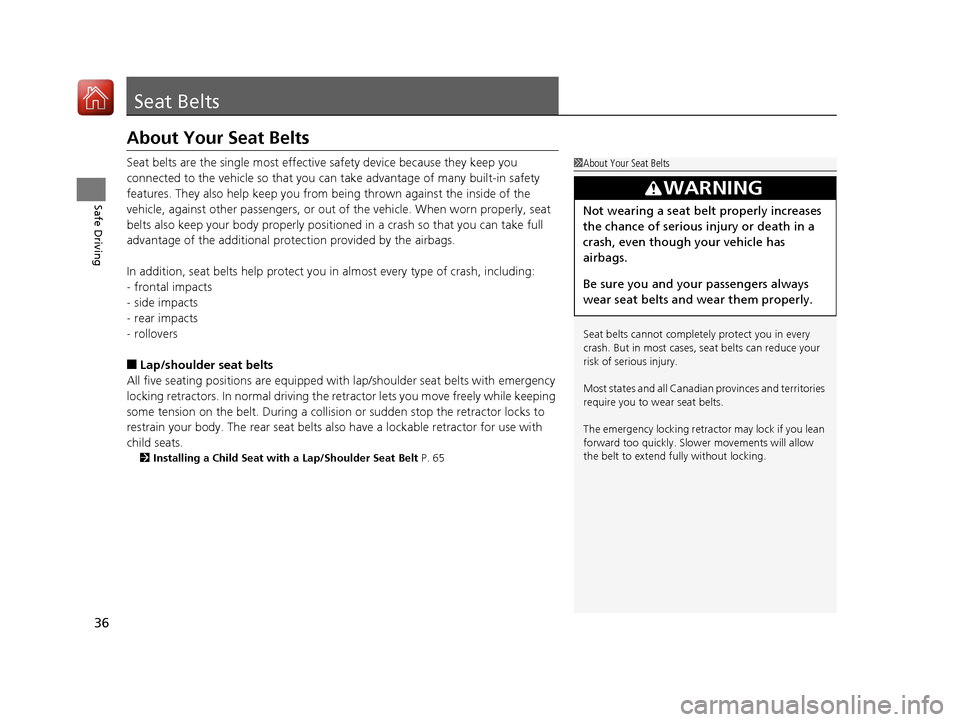
36
Safe Driving
Seat Belts
About Your Seat Belts
Seat belts are the single most effective safety device because they keep you
connected to the vehicle so that you can take advantage of many built-in safety
features. They also help keep you from be ing thrown against the inside of the
vehicle, against other passengers, or out of the vehicle. When worn properly, seat
belts also keep your body pr operly positioned in a crash so that you can take full
advantage of the additional protec tion provided by the airbags.
In addition, seat belts help protect you in almost every type of crash, including: - frontal impacts
- side impacts
- rear impacts
- rollovers
■ Lap/shoulder seat belts
All five seating positions are equipped with lap/shoulder seat belts with emergency
locking retractors. In normal driving the re tractor lets you move freely while keeping
some tension on the belt. During a collision or sudden stop the retractor locks to
restrain your body. The rear seat belts al so have a lockable retractor for use with
child seats. 2 Installing a Child Seat with a Lap/Shoulder Seat Belt P. 65
1About Your Seat Belts
Seat belts cannot completely protect you in every
crash. But in most cases, seat belts can reduce your
risk of serious injury.
Most states and all Canadian provinces and territories
require you to w ear seat belts.
The emergency locking retrac tor may lock if you lean
forward too quickly. Slower movements will allow
the belt to extend fu lly without locking.
3WARNING
Not wearing a seat belt properly increases
the chance of serious injury or death in a
crash, even though your vehicle has
airbags.
Be sure you and your passengers always
wear seat belts and wear them properly.
16 CIVIC 2D HC2 (0A 01 0C)-31TBG6000.book 36 ページ >0>.>/6年>0月>/>0日 金 曜日 午後4時>/6分
Page 60 of 585
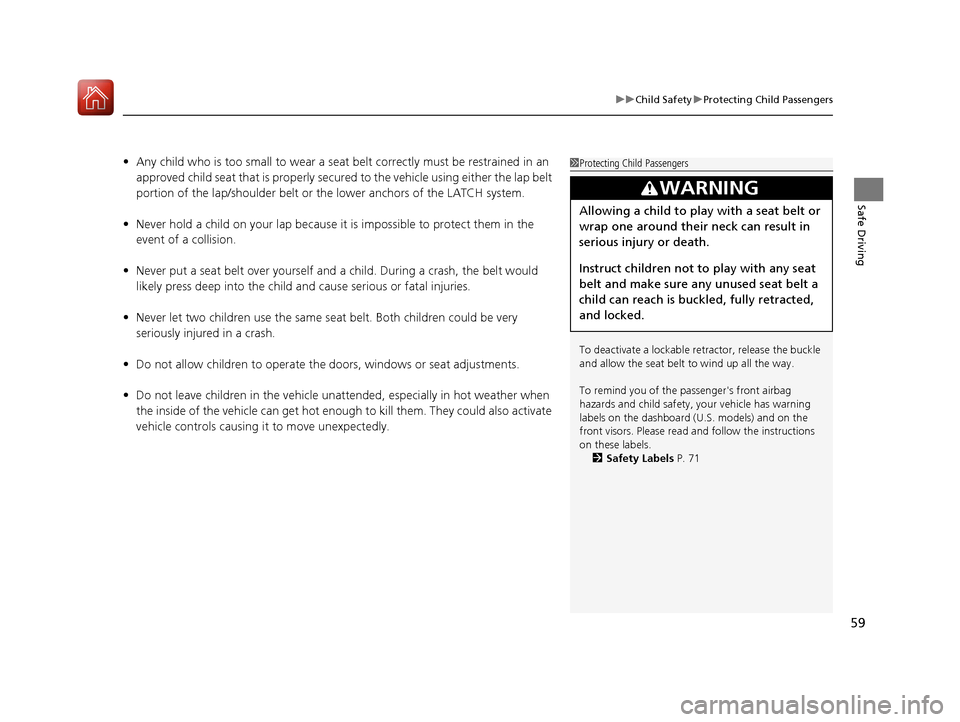
59
uuChild SafetyuProtecting Child Passengers
Safe Driving
•Any child who is too small to wear a seat belt correctly must be restrained in an
approved child seat that is properly secured to the vehicle using either the lap belt
portion of the lap/shoulder belt or the lower anchors of the LATCH system.
• Never hold a child on your lap because it is impossible to protect them in the
event of a collision.
• Never put a seat belt over yourself and a child. During a crash, the belt would
likely press deep into the child and cause serious or fatal injuries.
• Never let two children use the same seat belt. Both children could be very
seriously injured in a crash.
• Do not allow children to operate the doors, windows or seat adjustments.
• Do not leave children in the vehicle unattended, especially in hot weather when
the inside of the vehicle can get hot enough to kill them. They could also activate
vehicle controls causing it to move unexpectedly.1Protecting Child Passengers
To deactivate a lockable retractor, release the buckle
and allow the seat belt to wind up all the way.
To remind you of the pa ssenger's front airbag
hazards and child safety, your vehicle has warning
labels on the dashboard (U.S. models) and on the
front visors. Please read and follow the instructions
on these labels.
2 Safety Labels P. 71
3WARNING
Allowing a child to play with a seat belt or
wrap one around their neck can result in
serious injury or death.
Instruct children not to play with any seat
belt and make sure any unused seat belt a
child can reach is buckled, fully retracted,
and locked.
16 CIVIC 2D HC2 (0A 01 0C)-31TBG6000.book 59 ページ >0>.>/6年>0月>/>0日 金 曜日 午後4時>/6分
Page 61 of 585
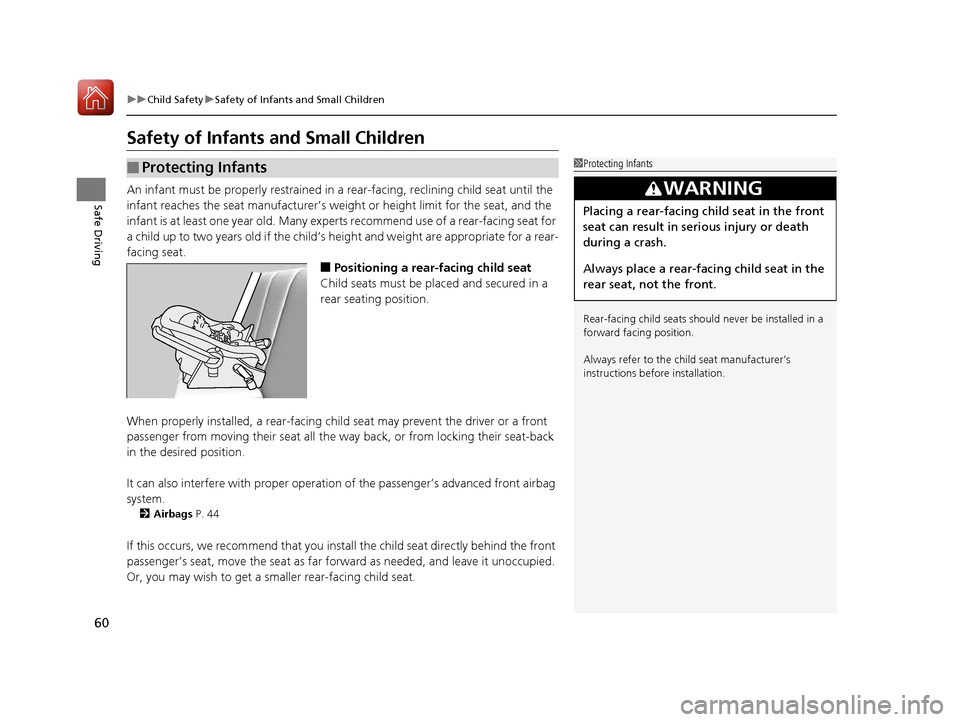
60
uuChild SafetyuSafety of Infants and Small Children
Safe Driving
Safety of Infants and Small Children
An infant must be properly restrained in a rear-facing, reclining child seat until the
infant reaches the seat manufacturer’s weig ht or height limit for the seat, and the
infant is at least one year old. Many expe rts recommend use of a rear-facing seat for
a child up to two years old if the child’s he ight and weight are appropriate for a rear-
facing seat.
■Positioning a rear-facing child seat
Child seats must be placed and secured in a
rear seating position.
When properly installed, a rear-facing child seat may prevent the driver or a front
passenger from moving their seat all the way back, or from locking their seat-back
in the desired position.
It can also interfere with pr oper operation of the passeng er’s advanced front airbag
system. 2 Airbags P. 44
If this occurs, we recommend that you install the child seat directly behind the front passenger’s seat, move the seat as far fo rward as needed, and leave it unoccupied.
Or, you may wish to get a sm aller rear-facing child seat.
■Protecting Infants1Protecting Infants
Rear-facing child seats should never be installed in a
forward facing position.
Always refer to the child seat manufacturer’s
instructions before installation.
3WARNING
Placing a rear-facing child seat in the front
seat can result in se rious injury or death
during a crash.
Always place a rear-fac ing child seat in the
rear seat, not the front.
16 CIVIC 2D HC2 (0A 01 0C)-31TBG6000.book 60 ページ >0>.>/6年>0月>/>0日 金 曜日 午後4時>/6分
Page 65 of 585
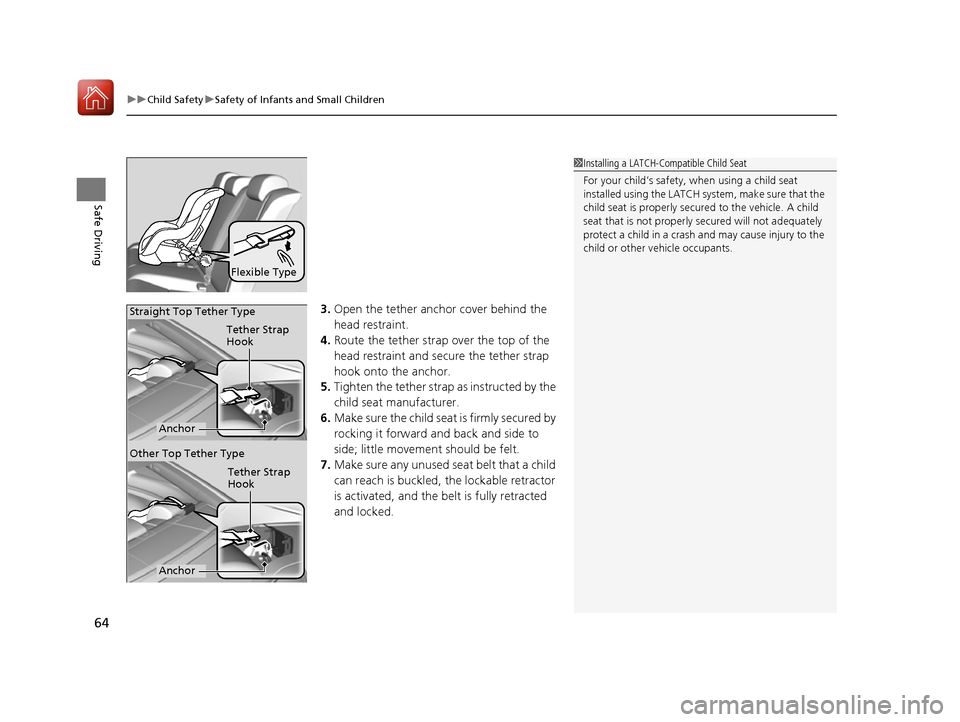
uuChild SafetyuSafety of Infants and Small Children
64
Safe Driving
3. Open the tether anchor cover behind the
head restraint.
4. Route the tether strap over the top of the
head restraint and secure the tether strap
hook onto the anchor.
5. Tighten the tether strap as instructed by the
child seat manufacturer.
6. Make sure the child seat is firmly secured by
rocking it forward and back and side to
side; little movement should be felt.
7. Make sure any unused seat belt that a child
can reach is buckled, the lockable retractor
is activated, and the be lt is fully retracted
and locked.
Flexible Type
1Installing a LATCH-Compatible Child Seat
For your child’s safety, when using a child seat
installed using the LATCH system, make sure that the
child seat is properly secured to the vehicle. A child
seat that is not properly secured will not adequately
protect a child in a crash and may cause injury to the
child or other vehicle occupants.
Tether Strap
Hook
Anchor
Straight Top Tether Type
Tether Strap
Hook
Anchor
Other Top Tether Type
16 CIVIC 2D HC2 (0A 01 0C)-31TBG6000.book 64 ページ >0>.>/6年>0月>/>0日 金 曜日 午後4時>/6分
Page 66 of 585
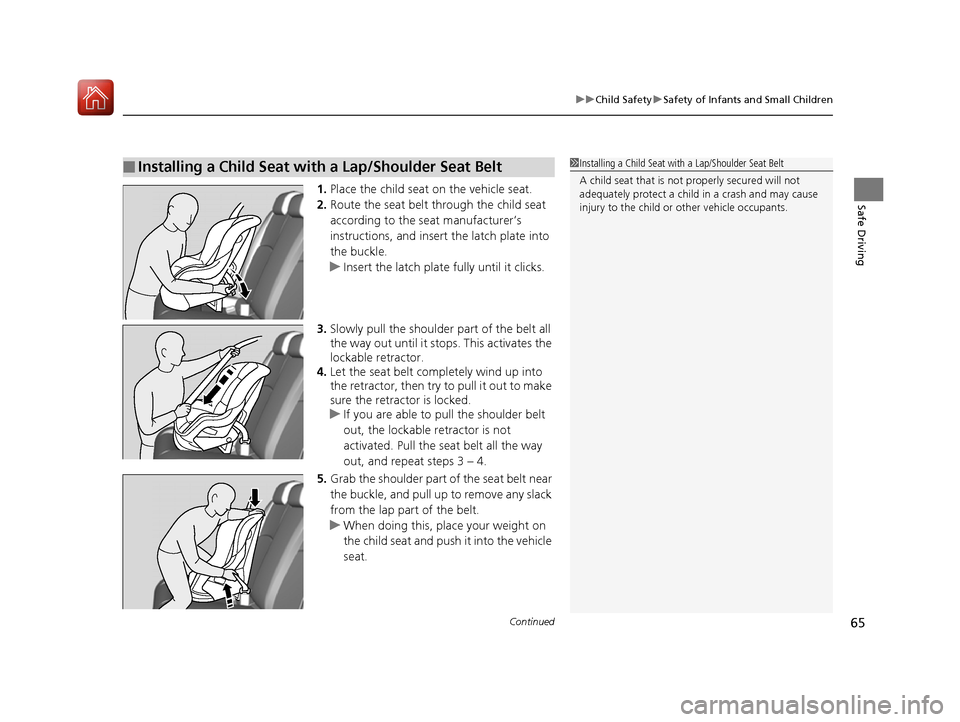
Continued65
uuChild SafetyuSafety of Infants and Small Children
Safe Driving1.Place the child seat on the vehicle seat.
2. Route the seat belt through the child seat
according to the seat manufacturer’s
instructions, and insert the latch plate into
the buckle.
uInsert the latch plate fully until it clicks.
3. Slowly pull the shoulder part of the belt all
the way out until it stops. This activates the
lockable retractor.
4. Let the seat belt completely wind up into
the retractor, then try to pull it out to make
sure the retractor is locked.
uIf you are able to pull the shoulder belt
out, the lockable retractor is not
activated. Pull the seat belt all the way
out, and repeat steps 3 – 4.
5. Grab the shoulder part of the seat belt near
the buckle, and pull up to remove any slack
from the lap part of the belt.
uWhen doing this, place your weight on
the child seat and push it into the vehicle
seat.
■Installing a Child Seat with a Lap/Shoulder Seat Belt1Installing a Child Seat with a Lap/Shoulder Seat Belt
A child seat that is not properly secured will not
adequately protect a child in a crash and may cause
injury to the child or other vehicle occupants.
16 CIVIC 2D HC2 (0A 01 0C)-31TBG6000.book 65 ページ >0>.>/6年>0月>/>0日 金 曜日 午後4時>/6分
Page 67 of 585
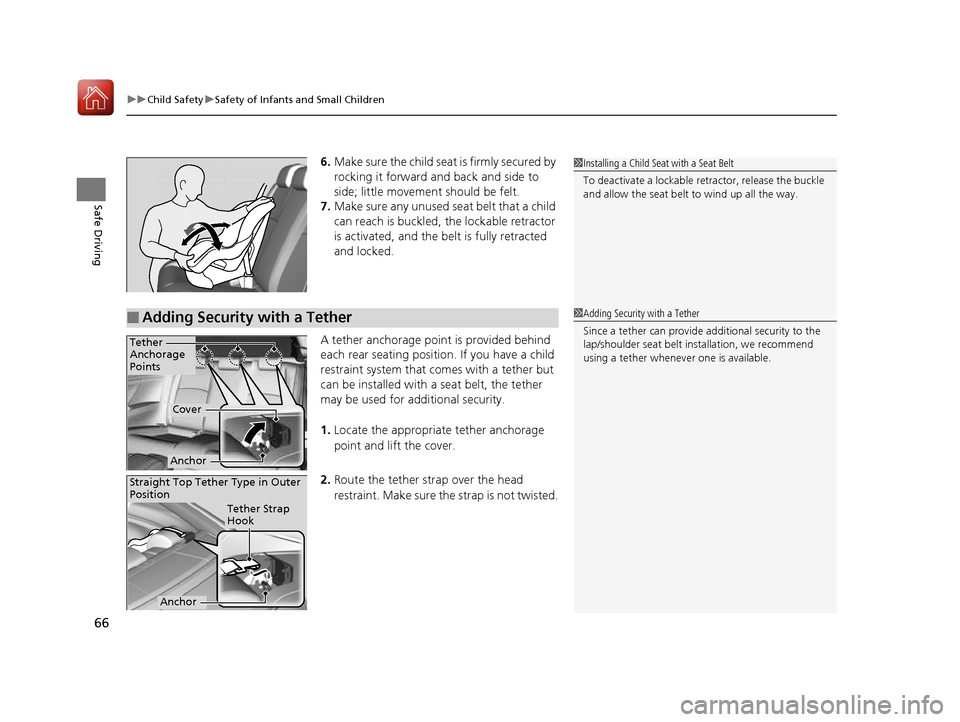
uuChild SafetyuSafety of Infants and Small Children
66
Safe Driving
6. Make sure the child seat is firmly secured by
rocking it forward and back and side to
side; little movement should be felt.
7. Make sure any unused seat belt that a child
can reach is buckled, the lockable retractor
is activated, and the be lt is fully retracted
and locked.
A tether anchorage point is provided behind
each rear seating position. If you have a child
restraint system that comes with a tether but
can be installed with a seat belt, the tether may be used for additional security. 1. Locate the appropriate tether anchorage point and lift the cover.
2. Route the tether strap over the head
restraint. Make sure the strap is not twisted.1Installing a Child Seat with a Seat Belt
To deactivate a lockable retractor, release the buckle
and allow the seat belt to wind up all the way.
■Adding Security with a Tether1Adding Security with a Tether Since a tether can provide additional security to the
lap/shoulder seat belt in stallation, we recommend
using a tether whenever one is available.
Tether
Anchorage
Points
Cover
Anchor
Straight Top Tether Type in Outer
Position
Tether Strap
Hook
Anchor
16 CIVIC 2D HC2 (0A 01 0C)-31TBG6000.book 66 ページ >0>.>/6年>0月>/>0日 金 曜日 午後4時>/6分